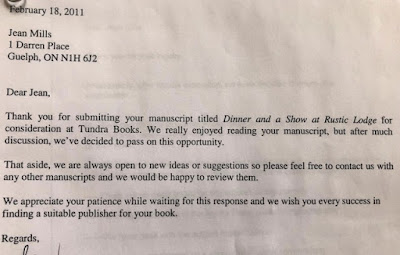I once received a review for a novel of
mine called Wild Dog Summer,
published by an educational publisher for a classroom novel study package.
“Flow-charted fiction.” That’s what the
reviewer said, along with some other highly uncomplimentary thoughts on my
writing ability, character development and general world view. (The words
“earnest” and “contrived” float to the surface of my memory…)
It hurt to read this review. It hurt for
all sorts of reasons:
I had been thinking of myself as a good – or at least a decent – writer. So, ouch.
This review was published in a journal dedicated to children’s literature. It would be read by teachers and librarians – in other words, the gatekeepers responsible for choosing books to use with kids in their middle school Language Arts programs. I heard the sound of a door slamming shut.
I was horrified that someone saw my work –
saw me – in this way. For weeks I couldn’t write. I doubted myself as a writer,
which is a terrible thing for someone who has defined herself by being a writer
her whole life. (Yes, that’s me, writing about myself in third person…)
Two things helped me recover my confidence.
First, my husband noticed that something
was up, read the review when I finally confessed my distress about it, and
said: “So? She didn’t like your book.”
In other words, so what? One person didn’t
like it. Whatever.
And second, I had already received messages
from teachers and students who had read the book and were enjoying it as part
of their school Language Arts program. Those messages continued to arrive –
enthusiastic and positive responses to my story and characters.
(I also did a bit of research on the
reviewer and discovered that her children’s literature cred was lacking. This
wasn’t a teacher, librarian or parent reviewing the book. This was a recent
university grad who worked in media and produced a short audio comedy series
making fun of “mini-van people.” Enough said.)
So, reviews.
When they’re good, we love them. When
they’re bad, it’s a bit more complicated.
Reviews help to sell books, so publishers
(and writers) need them. Publishers will rely on curated sources, with
reviewers who have been vetted, who have some expertise, whose views are edited
(hopefully) for accuracy and relevance.
That doesn’t mean the reviews are always
going to be positive. My self-published YA novel The Toymaker’s Son was
“recommended with reservations” by CM: Canadian Review of Materials, which is a
bit like receiving a pat on the head from someone who won’t make eye contact
with you.
But the online universe means anyone can be
a reviewer (cough, Goodreads, cough). Bloggers, vloggers, personal websites.
Reviews are everywhere.
So, I’m trying to keep it all in
perspective and appreciate the reality that not everyone is going to like my
book, my writing style or my characters (and let’s face it: to writers, our
characters are like our children to us! Beloved!).
My job is to write, listen to my editor
and, after publication, to my readers.
Which brings me to my final point.
As a writer of YA fiction, my favourite reviews
(sometimes in the form of personal messages, classroom feedback activities,
online comments) have come from the kids reading my books. Kids are honest,
which means the feedback is not always positive, but I’m absolutely okay with
that, because…
Who better to tell you if your story
resonates with the book’s intended audience than the book’s intended audience?
(Related thought: Throughout my
trying-to-get-published journey, I’ve wondered more than once whether
publishers are publishing what the adults want the kids to read, or what kids
want to read. Who drives the children’s publishing machine? Adult
readers/buyers/sellers or kid readers?)
So here’s a call-out to the world of
curated, edited review sites and publications:
If you’re reviewing books for kids, why not ask kids to contribute?
If you’re reviewing books for kids, why not ask kids to contribute?
How can writers, booksellers, teachers,
librarians, parents and the young readers themselves find out if a book – a
book aimed at young readers – actually appeals to kids? Let the kids tell us.
To conclude: Here's my favourite review of Skating Over Thin Ice, from Kids’ BookBuzz, written by Tatiana, age 15.
 |
| Thanks, Tatiana! |








